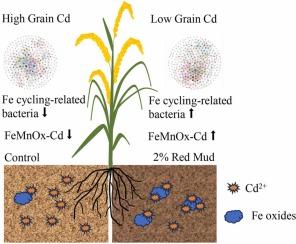在微镉污染水稻土中,赤泥对土壤微生物群落和镉组分的影响是动态的
IF 11.3
1区 环境科学与生态学
Q1 ENGINEERING, ENVIRONMENTAL
引用次数: 0
摘要
赤泥是一种富含氧化铁的高碱性工业副产物,具有修复土壤镉的巨大潜力。虽然赤泥在水稻盆栽和田间试验中稳定镉的报道较多,但赤泥对水稻土微生物群落的影响以及赤泥对镉稳定的贡献尚不清楚。本研究利用高通量测序和生物信息学技术,结合序列提取程序,确定了赤泥对水稻Cd还原的微生物机制和相应土壤Cd组分的信息。结果表明,赤泥显著提高了土壤pH值和铁锰氧化物结合的Cd组分。赤泥对微生物多样性的影响大于对α多样性的影响,尤其是对细菌。与铁还原有关的特殊类群(如厚壁菌门和厌氧杆菌属)在灌浆期富集,这可能有助于镉的稳定。赤泥对真菌群落的影响不大。在一个高Cd积累水稻品种中,2%赤泥改良成功地使籽粒Cd含量降低了72%。赤泥在短期内有效地减少了Cd的积累,并显示了补救应用的潜力。本研究为稳定赤泥中Cd提供了微生物学证据,但其长期环境影响和现场适用性有待进一步研究。本文章由计算机程序翻译,如有差异,请以英文原文为准。

Red mud causes dynamic changes in the soil microbial community and cadmium fractions in a slightly cadmium-contaminated paddy soil
Red mud is a highly alkaline industrial by-product rich in iron oxides with great potential for soil cadmium remediation. Although the stabilization of Cd by red mud is well reported in rice potted and field experiments, the influence of red mud on microbial communities in paddy soil and the contribution of soil microbial communities subjected to red mud in Cd stabilization remain unknown. This study used high-throughput sequencing and bioinformatics, combined with a sequential extraction procedure, to determine the microbiological mechanisms of rice Cd reduction by red mud and information on the corresponding soil Cd fraction. The results showed that red mud significantly increased the soil pH and iron and manganese oxide-bound Cd fractions. Red mud application influenced the microbial beta diversity rather than the alpha diversity, especially for bacteria. Unique taxa associated with iron reduction (e.g., phylum Firmicutes and genus Anaeromyxobacter) were enriched at the rice-filling stage, which may contribute to the stabilization of Cd. Red mud application caused little difference in the fungal communities. A 2 % red mud amendment successfully decreased the grain Cd content in a high Cd-accumulating rice cultivar by 72 %. Red mud effectively reduces Cd accumulation in the short-term and demonstrates potential for remedial applications. This study provides microbiological evidence for stabilizing Cd in red mud, but its long-term environmental impact and field applicability require further research.
求助全文
通过发布文献求助,成功后即可免费获取论文全文。
去求助
来源期刊

Journal of Hazardous Materials
工程技术-工程:环境
CiteScore
25.40
自引率
5.90%
发文量
3059
审稿时长
58 days
期刊介绍:
The Journal of Hazardous Materials serves as a global platform for promoting cutting-edge research in the field of Environmental Science and Engineering. Our publication features a wide range of articles, including full-length research papers, review articles, and perspectives, with the aim of enhancing our understanding of the dangers and risks associated with various materials concerning public health and the environment. It is important to note that the term "environmental contaminants" refers specifically to substances that pose hazardous effects through contamination, while excluding those that do not have such impacts on the environment or human health. Moreover, we emphasize the distinction between wastes and hazardous materials in order to provide further clarity on the scope of the journal. We have a keen interest in exploring specific compounds and microbial agents that have adverse effects on the environment.
 求助内容:
求助内容: 应助结果提醒方式:
应助结果提醒方式:


